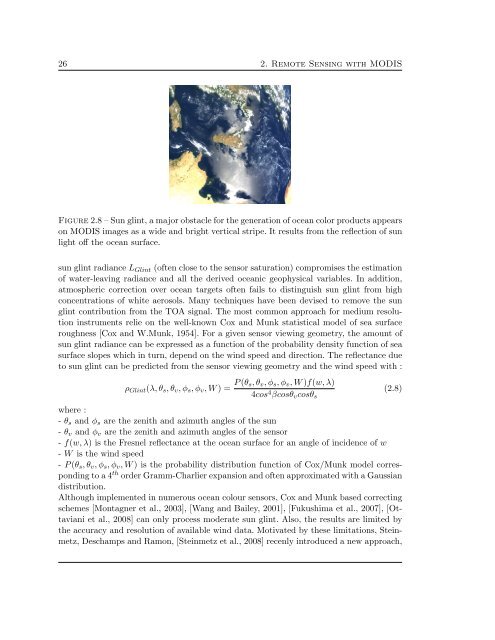Th`ese Marouan BOUALI - Sites personnels de TELECOM ParisTech
Th`ese Marouan BOUALI - Sites personnels de TELECOM ParisTech
Th`ese Marouan BOUALI - Sites personnels de TELECOM ParisTech
You also want an ePaper? Increase the reach of your titles
YUMPU automatically turns print PDFs into web optimized ePapers that Google loves.
26 2. Remote Sensing with MODIS<br />
Figure 2.8 – Sun glint, a major obstacle for the generation of ocean color products appears<br />
on MODIS images as a wi<strong>de</strong> and bright vertical stripe. It results from the reflection of sun<br />
light off the ocean surface.<br />
sun glint radiance L Glint (often close to the sensor saturation) compromises the estimation<br />
of water-leaving radiance and all the <strong>de</strong>rived oceanic geophysical variables. In addition,<br />
atmospheric correction over ocean targets often fails to distinguish sun glint from high<br />
concentrations of white aerosols. Many techniques have been <strong>de</strong>vised to remove the sun<br />
glint contribution from the TOA signal. The most common approach for medium resolution<br />
instruments relie on the well-known Cox and Munk statistical mo<strong>de</strong>l of sea surface<br />
roughness [Cox and W.Munk, 1954]. For a given sensor viewing geometry, the amount of<br />
sun glint radiance can be expressed as a function of the probability <strong>de</strong>nsity function of sea<br />
surface slopes which in turn, <strong>de</strong>pend on the wind speed and direction. The reflectance due<br />
to sun glint can be predicted from the sensor viewing geometry and the wind speed with :<br />
ρ Glint (λ, θ s ,θ v ,φ s ,φ v ,W)= P (θ s,θ v ,φ s ,φ v ,W)f(w, λ)<br />
4cos 4 βcosθ v cosθ s<br />
(2.8)<br />
where :<br />
- θ s and φ s are the zenith and azimuth angles of the sun<br />
- θ v and φ v are the zenith and azimuth angles of the sensor<br />
- f(w, λ) is the Fresnel reflectance at the ocean surface for an angle of inci<strong>de</strong>nce of w<br />
- W is the wind speed<br />
- P (θ s ,θ v ,φ s ,φ v ,W) is the probability distribution function of Cox/Munk mo<strong>de</strong>l corresponding<br />
to a 4 th or<strong>de</strong>r Gramm-Charlier expansion and often approximated with a Gaussian<br />
distribution.<br />
Although implemented in numerous ocean colour sensors, Cox and Munk based correcting<br />
schemes [Montagner et al., 2003], [Wang and Bailey, 2001], [Fukushima et al., 2007], [Ottaviani<br />
et al., 2008] can only process mo<strong>de</strong>rate sun glint. Also, the results are limited by<br />
the accuracy and resolution of available wind data. Motivated by these limitations, Steinmetz,<br />
Deschamps and Ramon, [Steinmetz et al., 2008] recenly introduced a new approach,















